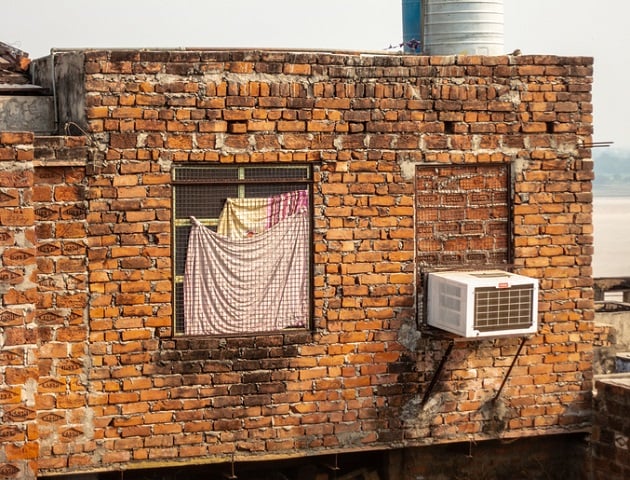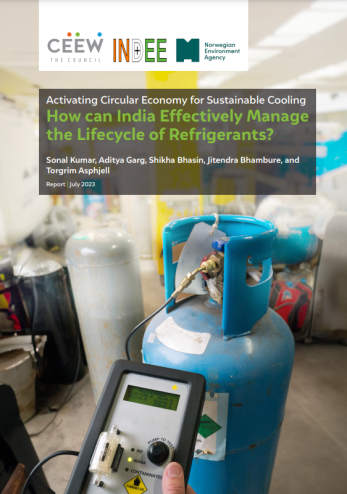



Suggested citation: Nain, Aarti and Shikha Bhasin. 2022. Making Sustainable Cooling in India Affordable – A Study of Financing Business Models. New Delhi: Council on Energy, Environment and Water.
The brief examines business models that address a key barrier to the uptake of sustainable cooling technologies – financing and affordability. The examined models —namely, cooling-as-a-service (CaaS), on-bill financing (OBF), dealer financing, leasing, energy service company (ESCO), and bulk procurement alleviate affordability of sustainable cooling technologies by either reducing prices or financing upfront costs. Through interactions with entrepreneurs and sustainable financing experts, the report spotlights key roadblocks and the ways for integrating these models in the Indian cooling sector.
In India, equitable access to sustainable cooling is exigent for climate sustainability, economic productivity, and public health. Greenhouse gas (GHG) emissions from cooling are estimated to account for at least 7 per cent of total annual national emissions by 2037. Considerable loss in labour productivity cannot be ruled out. As the planet warms up, 6 per cent of working hours may be lost to heat stress (ILO, 2019). Lack of respite from higher temperatures has already resulted in increased heat-related mortality cases and debilitating ailments such as organ failures and respiratory distress (National Disaster Management Authority 2019).
Regulations and financial support are equally important in guaranteeing access to low-emission cooling. Policies such as the India Cooling Action Plan, Standard and Labelling Scheme, and Energy Conservation Building Code have nudged supply and demand to some extent. Public investment through government technology deployment programmes (e.g., EESL’s Super-efficient Airconditioning Programme) has accelerated research and commercialisation of highly efficient products.
A key barrier that hinders mass adoption of sustainable cooling technologies despite favourable policies and public investment is that these technologies still remain unaffordable for the average buyer. While a majority of urban India is aware of energy efficiency programmes and appliances, less than 14 per cent of AC owning households have a 4- or 5- star labelled efficient AC; largely owing to budgetary constraints. (Bhasin et al 2021). Private-sector financing and the ingenuity of private actors in innovating technology and applying new models are needed to bridge this gap. This study was undertaken to examine business models that can deliver sustainable and affordable cooling profitably. Understanding the value additions of these business models and the factors that foster and inhibit their potential in India can inform pragmatic actions.
Most technology suppliers have largely ignored the latent market opportunity represented by consumers interested in, but unable to afford, cooling. So far, not many companies in India are pioneering new business models to sell sustainable cooling technologies or services. An inadequate financing ecosystem for entrepreneurs, seasonal usage, cost of capital and lack of awareness among potential consumers and investors, have emerged as the biggest roadblocks. Businesses face challenges of uninformed consumers, low consumerpaying capacity, and consumer reticence to experiment with nascent technologies. Remote and geographically disbursed markets pose problems for consumer acquisition and establishing effective after-sales service networks. Scalability and growth are hindered by inadequate risk cover to protect against investment losses, risk-averse lenders, and weak investor interest.
The market-centric models reviewed in this brief – namely, cooling-as-a-service (CaaS), on-bill financing (OBF), dealer financing, leasing, energy service company (ESCO), and bulk procurement –address the affordability of sustainable cooling technologies by either reducing prices of energy efficient products or financing 100 per cent of the upfront costs. CaaS frees the end user from managing cooling systems. It inherently promotes low-emission technologies. Savings in the operational costs of cooling and refrigeration systems multiply profits for providers and affordability for end users. ESCO reduces consumer risks associated with investing in efficiency and minimises upfront costs. Dealer financing, leasing, and OBF help consumers with inadequate assets meet upfront costs. Bulk procurement makes newly commercialised or yet-to-becommercialised technologies cost-effective.

A combination of strategies are required to increase equity investment and motivate consumer familiarity with these models, the technologies they espouse and their benefits.
Entrepreneurs that seek to increase the affordability of low-emissions cooling products must have increased access to private equity. Start-ups in the cooling sector are too small to qualify for debt financing, and, hence, they depend on equity to operate and grow. Domestic investors expect aggressive returns, and consider these business models inherently risky due to the perceived low credit worthiness of the end users served. Cost of financing is also high in India. As a result, investment flows remain limited and businesses rely almost exclusively on international social impact investors, concessional loans, and non-returnable grants from development organisations or philanthropic funds.
To scale, businesses working with models such as CaaS or OBF will require commercial debt. Commercial lending institutions must be made aware of the bankability of these businesses and their customers. Loan products, which specifically address the peculiarities of cooling markets, and well-designed risk guarantee instruments must be introduced. Currently, risk guarantees for efficiency and clean energy are primarily facilitated by development banks, but they do not address the techno-commercial risks.
Retail consumers must be made aware of value and the significance of lifetime-ownership costs over immediate-ownership costs to create demand for sustainable cooling systems. Traditional marketing messages, which target price sensitivity of retail consumers, emphasise the immediate affordability of cooling systems. Energy-use efficiency and its long-term benefits for owners and the climate are ignored; the resulting consumer perceptions must be overturned.
Consumer demand for climate-friendly cooling must be reinforced through mandatory regulations. Regulations in favour of low-emission cooling other than the Standard and Labelling (S&L) programme, and Perform, Achieve and Trade (PAT) scheme, are voluntary. Mandatory use of sustainable cooling systems in the public sector and stricter enforcement of energy efficiency codes can help build the demand for innovative business models. Energy Conservation Building Codes for commercial and residential buildings can be turned into mandatory norms. Equipment replacement policies at manufacturer recommended lifecycles can also be introduced.
Finally, consumer behaviour, supply chain capacity, environmental or efficiency performance norms and nuances of these models itself must be studied in detail and continuously to refine their applicability and enhance their potential for overcoming barriers to supply of affordable, sustainable cooling technologies.

Activating Circular Economy for Sustainable Cooling

Activating Circular Economy for Sustainable Cooling

Activating Circular Economy for Sustainable Cooling

Activating Circular Economy for Sustainable Cooling